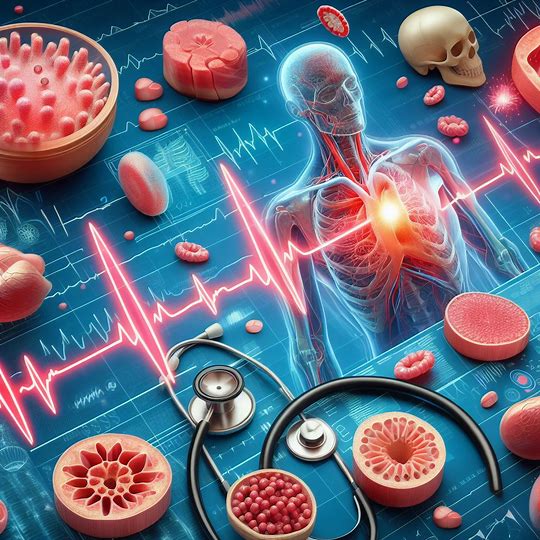Get expert insights on irregular heartbeat – learn about its symptoms, causes, and when to seek medical advice for this common cardiac condition.
Table of Contents
Introduction – Irregular Heartbeat
An irregular heartbeat, known as an arrhythmia, occurs when the heart beats too fast, too slow, or with an erratic rhythm. When the electrical impulses that coordinate heartbeats don’t work properly, various types of arrhythmias can occur, impacting how well the heart works. Understanding this condition is crucial because some arrhythmias may have little to no symptoms or consequences. In contrast, others can significantly affect the quality of life or lead to serious health problems like stroke or heart failure.

Symptoms of arrhythmias can vary widely, from a fluttering in the chest to a racing heartbeat or even a slow pulse. Some individuals may experience dizziness, shortness of breath, or chest pain, prompting them to seek a doctor’s expertise. Diagnosis typically involves a medical history review, physical exam, and specific electrocardiogram (ECG) tests. Treatment strategies are just as varied as the symptoms and types of arrhythmias, ranging from lifestyle changes and medications to advanced procedures like cardiac ablation or pacemaker insertion. Understanding available treatment options helps individuals navigate their path to managing an irregular heartbeat.
Living with arrhythmia involves awareness of one’s own body and knowing when to seek medical advice. Early diagnosis and treatment may prevent more severe consequences and can improve an individual’s well-being and ability to lead an active life. Therefore, learning about arrhythmia is not just about recognition; it’s about knowing the steps for effective management and maintaining cardiovascular health.
Key Takeaways
- Arrhythmia disrupts normal heart rhythm and varies in severity.
- Symptoms can include palpitations, dizziness, or shortness of breath.
- Treatment may involve medications, lifestyle changes, or procedures.
Understanding Heart Rhythms

The human heart relies on a complex electrical system to maintain a regular heartbeat and rhythm. Under normal circumstances, the heart rate is governed by these electrical signals, which ensure that the heart’s upper chambers (atria) and lower chambers (ventricles) contract in a coordinated manner. The standard pulse ranges between 60 to 100 beats per minute at rest.
An irregular heartbeat, known as arrhythmia, occurs when these electrical impulses do not function correctly. As a result, the heart may beat too fast (tachycardia), too slow (bradycardia), or in an erratic pattern. Two such instances are atrial fibrillation, where the upper chambers quiver chaotically, and atrial flutter, which is characterized by a fast and regular rhythm due to a circuit loop within the atria.
Understanding the nuances of the heart’s rhythms is crucial for recognizing symptoms and preventive measures for arrhythmias. Disruptions in the heart’s rhythm may lead to palpitations, dizziness, or shortness of breath and can have underlying causes ranging from heart disease to external stressors.
Key Findings
| Entity | Description | Source URL |
|---|---|---|
| Electrical Signals | Control the timing of heartbeats | Mayo Clinic |
| Atrial Flutter | Rapid rhythm of upper chambers | Heart Research Institute |
| Heart Chambers | Upper (atria) and lower (ventricles) | American Heart Association |
Arrhythmias may be symptomatic of other cardiac issues and need appropriate diagnosis and management to minimize health risks. With advancements in medical science, there are now a number of treatment options available to maintain a regular heartbeat and improve the quality of life for individuals with arrhythmias.
Types of Arrhythmias

Arrhythmias, also known as irregular heart rhythms, manifest when the heart’s electrical impulses, which coordinate heartbeats, malfunction. Understanding the distinct types of arrhythmias is essential because they affect the heart differently.
Atrial Fibrillation
Atrial fibrillation* (AFib) is the most common form of serious arrhythmia, characterized by a rapid and irregular heartbeat that can lead to stroke and other heart-related complications. Those with AFib may experience episodes of palpitations or a sensation of a skipped beat.
Ventricular Fibrillation
Ventricular fibrillation is a severely abnormal heart rhythm that is life-threatening and requires immediate medical attention. It is characterized by a fast, chaotic heartbeat where the lower chambers quiver and can’t pump blood, causing cardiac arrest.
Supraventricular Tachycardia
Supraventricular tachycardia (SVT) refers to any arrhythmia that originates above the heart’s ventricles. It is a broad term covering a range of conditions in which the heart can suddenly start beating extremely fast but maintains a regular rhythm.
Ventricular Tachycardia
Ventricular tachycardia (VT) occurs with repetitive, regular beating of the ventricles that is too fast. It can result in inadequate blood flow throughout the body and may precede ventricular fibrillation.
| Key Findings | Related Keywords | Sources |
|---|---|---|
| AFib is the most common serious arrhythmia | atrial fibrillation, palpitations | Mayo Clinic |
| Ventricular fibrillation can be deadly | ventricular fibrillation, cardiac arrest | Verywell Health |
| SVT can cause a sudden rapid heartbeat | supraventricular tachycardia | Stanford Health Care |
| Ventricular tachycardia may lead to insufficient blood flow | ventricular tachycardia | Cleveland Clinic |
Symptoms and Causes

Irregular heartbeat, known medically as arrhythmia, can present through various symptoms, and its origins stem from multiple causes ranging from lifestyle factors to underlying medical conditions.
Recognizing Symptoms
Symptoms of an irregular heartbeat are diverse and can be experienced as a fluttering sensation, chest pain, or the feeling of the heart pounding. Individuals might also encounter shortness of breath, fainting, or dizziness. Palpitations are another common symptom, manifesting as an irregular pounding or fluttering sensation in the chest.
| Key Symptoms | Description |
|---|---|
| Chest Pain | Discomfort or pressure in the chest |
| Palpitations | The noticeable beating of the heart, which may be rapid or irregular |
| Shortness of Breath | Difficulty breathing, which may occur at rest or during physical activity |
| Dizziness | A lightheaded, woozy sensation |
| Fainting | Sudden loss of consciousness |
Understanding Causes
The causes of irregular heartbeat range from stress and lifestyle choices such as caffeine consumption, alcohol intake, and smoking, to more serious conditions like a heart attack or stroke. Damage to the heart’s structure from a heart attack or the presence of other forms of heart damage are significant contributors. Additionally, fever and electrolyte imbalances due to illness can also trigger arrhythmias.
| Possible Causes | Description |
|---|---|
| Heart Attack | Damages the electrical pathways in the heart’s pumping system |
| Lifestyle Factors | Stimulants such as caffeine and habits like alcohol use and smoking |
| Stress | Emotional responses can affect the heart’s rhythm |
| Medical Conditions | Conditions like high blood pressure or thyroid disease can cause arrhythmias |
More information about heart arrhythmia symptoms and factors influencing irregular heartbeat are meticulously documented at the Mayo Clinic, offering in-depth perspectives. Additional insights into the conditions that may lead to irregular heartbeat can be found through the data provided by Heart Research Institute.
Diagnosis and Testing

Before a doctor can treat an abnormal heart rhythm, thorough diagnosis and testing must be conducted to understand the condition. This can include taking a detailed medical history, conducting a physical examination, and utilizing various electrical diagnostics to assess the heart’s activity.
Medical Evaluation
Medical history and physical examinations are the first steps in diagnosing heart rhythm issues. A doctor will assess symptoms, health background, family history of heart disease, and any current medications that can affect heart rhythm. This conversation may lead to running specific tests to investigate further.
Electrical Diagnostics
Electrocardiogram (ECG or EKG) is a fundamental test used to detect abnormal heart rhythms. This test records the electrical activity of the heart and is often the first diagnostic tool employed. For extended monitoring, a Holter monitor, a portable device worn for 24 to 48 hours, provides continuous ECG tracking. An exercise stress test can uncover rhythm problems induced by exertion. In some cases, an echocardiogram—an ultrasound of the chest—is used to visualize the heart’s structure and check for any underlying issues. Testing electrolytes in the bloodstream is also critical, as imbalanced levels can contribute to arrhythmias.
| Test Type | Description |
|---|---|
| Electrocardiogram (ECG) | A quick and non-invasive test that records the electrical signals of the heart. Mayo Clinic |
| Holter Monitor | A portable device for monitoring the heart’s rhythm over a 24-48 hour period. American Heart Association |
| Exercise Stress Test | A test that measures heart function and rhythm during physical exertion. American Heart Association |
Through these diagnostic tests, healthcare providers can effectively identify and classify various types of arrhythmias, laying the groundwork for a tailored treatment plan.
Treatment Strategies

Effective management of irregular heartbeat often involves a multifaceted approach that includes both lifestyle adjustments and medical or procedural interventions. Proper treatment can prevent complications such as stroke and cardiac arrest.
Lifestyle and Medication
For many individuals with irregular heart rhythms, initiating lifestyle changes alongside medication is a fundamental step. Regular exercise, maintaining a healthy weight, and avoiding caffeine or alcohol can decrease the occurrence of arrhythmic events. Medications play a pivotal role, and may include beta-blockers or digoxin, which aim to control heart rate and improve symptoms. Additionally, anticoagulants may be prescribed to minimize the risk of blood clots and stroke, particularly in those with atrial fibrillation.
Key Medications & Lifestyle Adjustments:
| Medication | Purpose | Lifestyle Change | Impact |
|---|---|---|---|
| Beta-blockers | Rate control | Exercise | Reduces arrhythmia frequency |
| Digoxin | Improve heart efficiency | Weight management | Decreases heart strain |
| Anticoagulants | Prevention of blood clots | Limit caffeine/alcohol | Lowers risk of arrhythmia-triggered events |
Sources for Medications & Lifestyle:
| Source | Link |
|---|---|
| Mayo Clinic – Diagnosis and treatment | mayoclinic.org |
| American Heart Association – Prevention and Treatment | heart.org |
Procedural Interventions
When medications and lifestyle alterations are insufficient, procedural strategies such as electrical cardioversion, pacemaker implantation, or surgery may be necessary. An EKG guides these procedures and helps in diagnosing the type of arrhythmia. Electrical cardioversion can reset the heart’s rhythm, while a pacemaker can correct rhythms that are too slow. In cases of severe cardiomyopathy or advanced heart block, surgical intervention may be the best course to prevent adverse outcomes.
Key Procedural Interventions & Outcomes:
| Intervention | Condition Addressed | Outcome |
|---|---|---|
| Electrical Cardioversion | Atrial Fibrillation | Restores normal heart rhythm |
| Pacemaker | Bradycardia | Maintains proper heart rate |
| Surgery | Severe Cardiomyopathy | Improves heart function and prevents heart block |
Sources for Procedural Interventions:
| Source | Link |
|---|---|
| Cleveland Clinic – Arrhythmia | clevelandclinic.org |
| Mayo Clinic – Atrial Fibrillation | mayoclinic.org |
Living with Arrhythmia
Living with arrhythmia requires understanding the condition and managing it effectively. An arrhythmia is a disruption in the heart’s normal rhythm, which can manifest as a too slow (bradycardia) or too fast (tachycardia) heart rate. It’s crucial for individuals with this condition to monitor for signs such as fatigue, lightheadedness, and palpitations. Adopting a heart-healthy lifestyle, which includes avoiding nicotine and managing anxiety, can help reduce symptoms and improve quality of life.
Treatment for arrhythmia might involve drugs to control heart rate and rhythm, and in some cases, surgery or other procedures might be necessary. Afib, or atrial fibrillation, is a common type of arrhythmia that can increase the risk of heart failure and other heart-related complications. Routine check-ups with a healthcare provider are crucial in managing the risks associated with heart disease.
People with arrhythmias should also be conscious of their blood pressure and recognize when an emergency warrants immediate attention, which might include administering CPR in severe cases. Other health conditions such as sleep apnea and dysfunction of the sinus node can affect the heart’s rhythm, so it’s important to treat any underlying conditions.
Key strategies for living with arrhythmia involve being aware of personal risk factors and recognizing symptoms such as pain or irregular blood flow. It’s also recommended to understand how to reduce potential triggers for PVCs (premature ventricular contractions) and to stay informed about the condition.
| Key Findings | Relevance |
|---|---|
| Consistent monitoring of heart rate | Identifies irregularities |
| Lifestyle adjustments | May reduce symptoms |
| Regular medical consultations | Essential for effective management |
Remember, consulting with a healthcare professional is always recommended for personalized advice and treatment options.
| Recommended Actions | Source |
|---|---|
| Monitoring heart rate changes | Detecting Arrhythmias |
| Adopting a heart-healthy diet | Arrhythmia & Diet |
| Avoiding stress and nicotine | Managing Risk Factors |
Frequently Asked Questions
This section addresses common queries about irregular heartbeats, known as arrhythmias, providing insights into their symptoms, causes, treatments, and effects on health.
What are the signs and symptoms of an irregular heartbeat?
Arrhythmias may cause palpitations, a sensation of a fluttering heart, dizziness, or shortness of breath. For more detailed symptoms, Verywell Health offers an in-depth look at how these manifest.
What are the leading causes of heart rhythm disorders?
Heart rhythm disorders can be due to heart disease, changes in heart tissue, or electrolyte imbalances. Mayo Clinic discusses several underlying conditions contributing to these disorders.
What are the most effective treatments for an irregular heartbeat?
Treatments range from medication and lifestyle changes to medical procedures like cardiac ablation. The Mayo Clinic provides an extensive list of potential treatment options for arrhythmias.
How does an irregular heartbeat impact long-term health and lifespan?
Persistent arrhythmias can lead to complications like stroke or heart failure, potentially affecting longevity. Temple Health explains the long-term impacts of heart arrhythmias on health.
What types of heart rhythm disorders are commonly diagnosed?
Common disorders include atrial fibrillation, bradycardia, and tachycardia. Detailed information on types of arrhythmias can be found on WebMD’s resource page.
At what point should one seek medical advice for heart palpitations?
Medical advice should be sought if palpitations are frequent, persistent, or associated with dizziness or chest pain. Additional guidance is provided by Temple Health on when to consult a healthcare provider.
| Key Findings | Sources |
|---|---|
| Signs and symptoms of an irregular heartbeat | Verywell Health |
| Causes of heart rhythm disorders | Mayo Clinic |
| Treatments for an irregular heartbeat | Mayo Clinic Treatment |
| Impact on long-term health and lifespan | Temple Health |
| Commonly diagnosed heart rhythm disorders | WebMD |
| When to seek medical advice | Temple Health Advice |




